You’ve probably seen the glowing headlines as the local media can’t stop wagging their tails. But behind the news reports that this is GRAND there are Animal Advocates who are growling. From questionable facility operations and designs to compliance and transparency concerns many are asking: Who’s this facility really serving — the animals, or the headlines?
Dana Baird, City of Frisco Communications Director, was right about one thing in her press release “its a first of its kind” but where she was wrong was “in North Texas.” After reading everything sent to us by animal advocates this type of facility with a “private partner” which really means “PRIVATE BUSINESS” has never been done anywhere from our research. Ms. Baird made sure WFAA, her former employer, only reported the “GOOD NEWS” like she usually does.
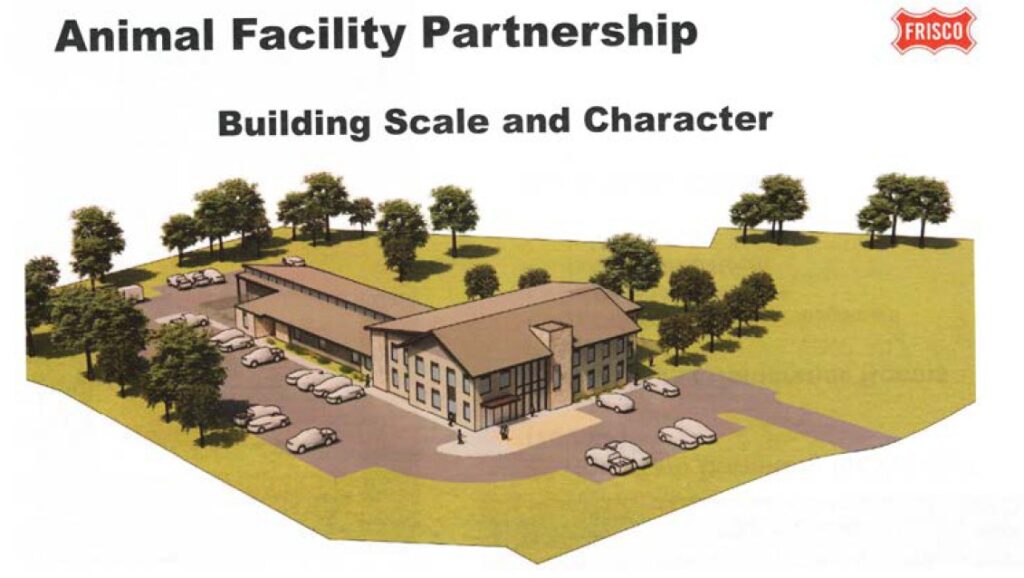
Yesterday we were cc/d on an email sent to everyone on the City Council, most of the folks in the City Manager’s Office, and almost every news outlet in town (including us). My guess, it won’t be published by any local news outlet because we never anything “bad” published against the city. The email also included several local animal advocates and rescue folks in Frisco.
What was the consensus? They animal welfare folks are growling at the new proposal, and one said to us off the record that “we feel this was thrown up in time for election season and to shut down animal advocates who have been working for years for a full-service animal hub / shelter (not a holding facility).” After reviewing the presentation, we tend to agree! Link for presentation is at the end of this blog!
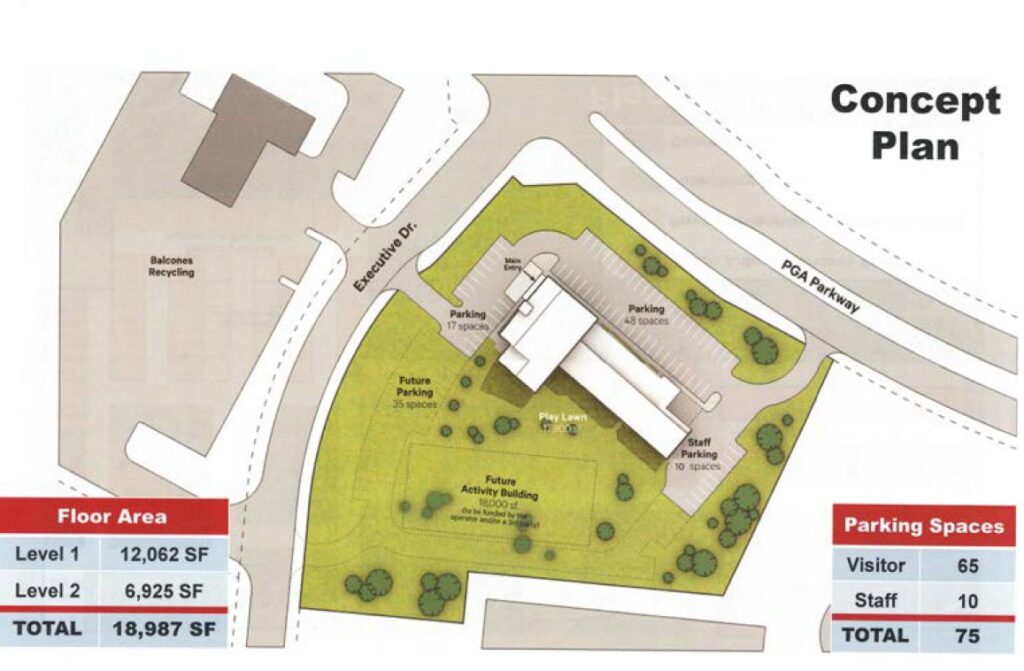
We will publish the letter sent to the city and media in its entirety below. We don’t know much about animal welfare, but we can understand the concerns after reading it. In my opinion, this appears to be a $12 million facility funded by CDC taxpayer money to support a private business. If that is the case, why not fund downtown and #SAVEMAIN? The building will be a two-story structure with a floor plan of 18,987 square feet. How does that break down? The breakdown: 10,769 square feet will be used by the private business, 5,277 square feet belong to the City of Frisco, and 1,100 square feet will be for utility space for both, such as laundry, storage, electrical, and janitorial. The private partnership is with a for-profit business called Wiggle Butts, and they will rent out space to a tenant (veterinarian). The question we have is why they have not held any community sessions or input sessions like they did for Universal Kids or the Performing Arts Center. With to little information and what looks like rushed planning, this looks like a hot mess. After reading the letter, I agree with the Animal Advocates that this has too many potential risks.
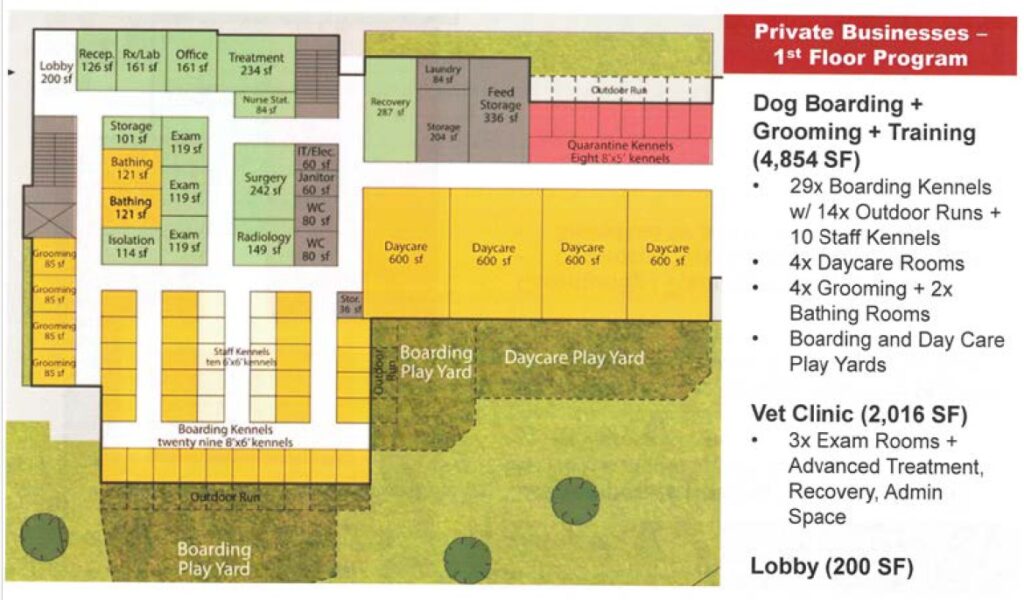
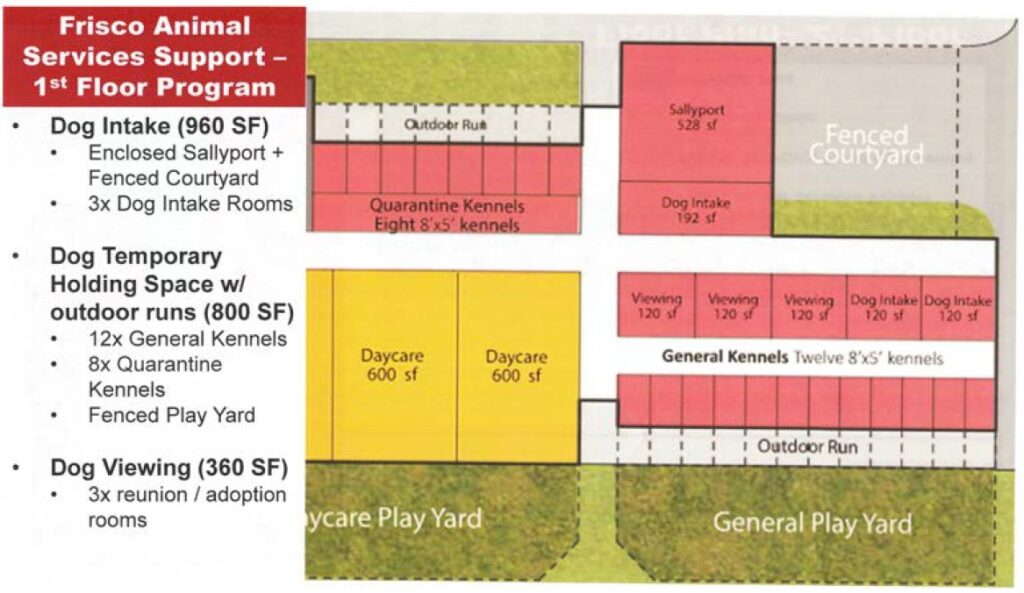
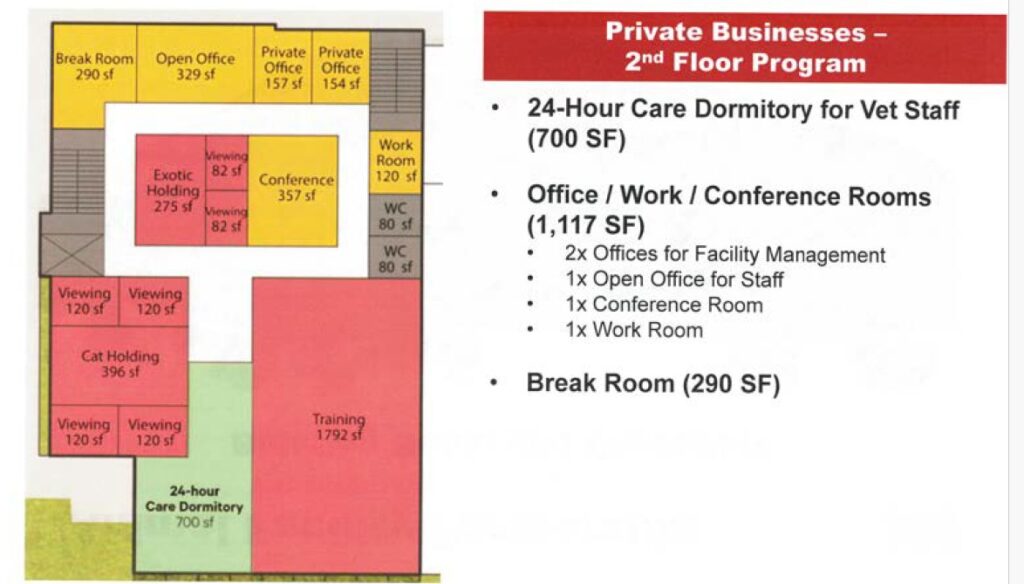
Dear Council Members,
This email was put together by several animal advocates who have concerns over the new Animal Holding Facility. While I know this email will be long, I encourage you to read it thoroughly because the liability the city could potentially hold with this model could be costly.
There is a reason animal shelters across the country don’t mix owner owned dogs with stray or adoptable animals. Most public/private partnerships across the United States are done with groups like ASPCA, Humane Society, Best Friends where they run an entire operation for a municipal entity. Why? There is too much liability when you have a “privately owned for profit business operation” within the same facility. The current presented facility violates your own Frisco ordinance today for kennel operations and is a liability to taxpayers who will end up footing the bill in a lawsuit.
Here are the concerns and questions from local animal advocates across Frisco after the recent work session related to the facility operations & design, veterinary services & oversight, financial & contractual concerns, public safety & liability, animal intake & disposition, the relationship with CCAS, staffing & training, legal & regulatory compliance and transparency concerns.
- Facility Operation & Design
Two key areas of design in shelters are functionality and public health and safety. Shelters (aka holding facilities) must meet Texas Administrative Code (TAC), Title 25, Part 1, Chapter 169, Subchapter A (Rabies Control) and Health & Safety Code Chapter 826. Functionality or Flow Efficiency is important. A one-way flow design that allows animals to move from intake à medical à adoption/release (or in this case transfer to CCAS) without backtracking to prevent contamination. The current design does not have a “one-way flow” at all!
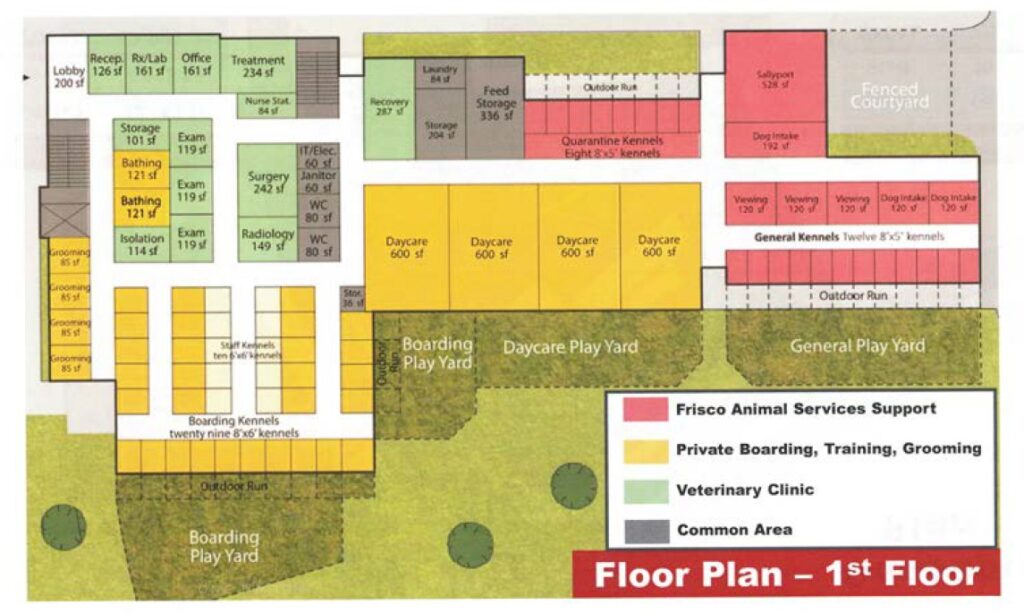
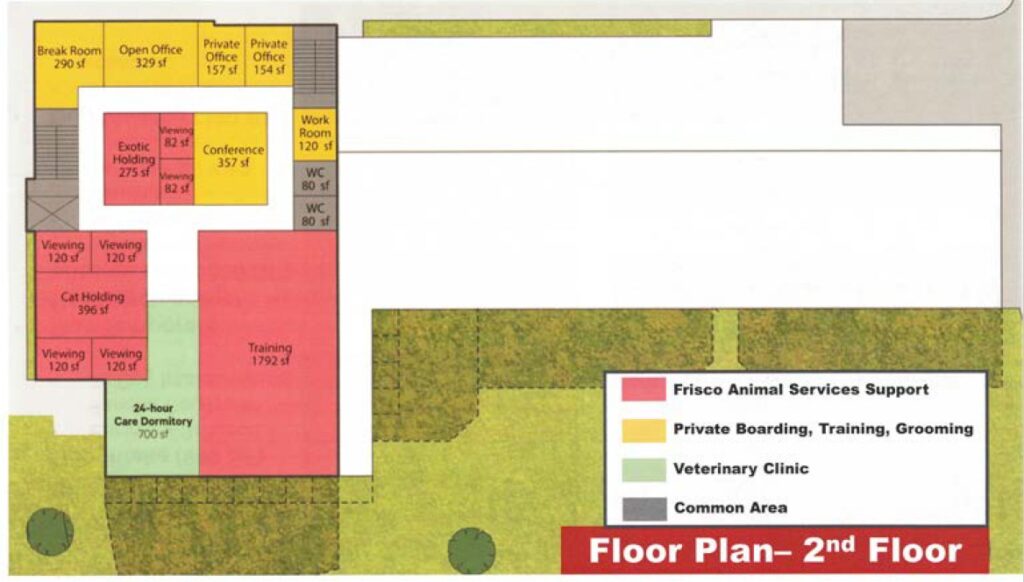
If Frisco Animal Services drops off a dog via the sallyport it will be moved into the “dog intake” area and then transferred over to the quarantine kennels or general kennels. The hallway space is not self-contained meaning airborne zoonotic diseases can transfer to other animals in that hallway space. Now let’s say one of the stray dogs needs to see the vet and you walk it down the hallway to the “green area” for vet care, that dog could have potentially contaminated that main hallway.
Contagious Diseases (some deadly) such as Parvo, Distemper, Upper Respiratory are transferred by touch, clothes, shoes, or airborne. Even if you have separate HVAC systems in the kennel runs that does not protect “owner owned dogs” that are being paid to be boarded at a private business from contamination in these hallways or walkways. This is a serious liability to the city and the business. It can also have deadly consequences for owned dogs.
Now Wiggle Butt has a dog in boarding, and they move the dog out of the yellow kennels and over to the “daycare” space which is accessed off the same main hallway. What happens? If the stray that was in the hallway before the “owner owned dog” is unvaccinated, carrying a contagious disease it could potentially transfer that to that owner owned dog. Owner owned pets can have not contact AT ALL with strays which is why at shelters they have specific areas for meet and greets or pet introductions. The layout of this facility is a walking liability for taxpayers, residents, Frisco pets, the city and this business.
This leads to the following set of questions because the disease prevention and control aspects of this design are very worrisome.
- Has the city conducted a FORMAL FEASIBLITY STUDY? No! Why not?
The city has done this for every other project, including the recent Performing Arts Center.
- Why not use a legitimate company like Quorum to do a formal feasibility study because this presentation does not reference best practices in municipal animal care.
- Quorum / Shelter Planners of America can give you better demand planning than using arbitrary numbers from Collin County that do not truly represent Frisco’s intake.
- Who helped design this model? What professional input did you have?
- How was the kennel count determined? No data sets were given, and did you consider the forecast for today vs 10 years from now?
- What experts were consulted on the design and functionality of this building? (outside of those who have a vested interest)
- While Councilwoman Laura Rummell has stated online that design will have different HVAC systems that does not matter in shared spaces. Please explain in more detail which areas will have separate systems with separate air zones?
- Will the HVAC systems be in compliance with the Association of Shelter Veterinarian standards?
- Which veterinarian’s (other than those with a vested interest) were consulted for input in this design? Did any of them specialize in shelter medicine?
- Will the private partner and its staff be required to take the same certification classes on Zoonotic Disease control that Animal Control Officers are required to take?
- What will the cleaning workflow be? Where will cleaning supplies be stored? In the storage room on the main hallway? Will the supplies be used on both sides of the facility?
- Will you have separate cleaning equipment and facilities for the “Frisco side” versus the “private business side” to prevent complete contamination by staff from one area to another? For example, will use the same floor mops throughout the facility?
- Where will the food bowls be washed and cleaned?
- How will the private business / city prevent airborne zoonotic diseases being transferred by clothes, shoes, hands, etc., around the facility to different areas of when they are crossing over areas where you have owner owned dogs?
- If you must take a dog from the “Frisco” side to the medical area to see the vet (in green) how will you prevent diseases from being transferred to the staff kennels, daycare and grooming area. They must walk right into it to get the medical portion of the building.
- Will used food and water bowls be transported back and forth in the main hallway to the feed storage room after the dogs have used them allowing potential airborne diseases to be released in the main hallway?
- For liability reasons we are curious why privately (owner-owned) boarded animals are located directly next to quarantine and adoptable animals that have the risk of disease?
- Who was the architect for this project? Do they have any experience in animal shelter designs?
- What SOP will be in place and has it been written with the help of experts to confirm sick/healthy animals will be physically separated? Especially from “owner owned dogs” that are in the care of the private business housed in the same facility.
2. Animal Intake & Disposition
- What isolation set up will you have for the first 24 hours an animal is in the facility to watch for illness before putting a dog in the “Frisco kennels”?
- What types of oversight and reporting methods will this private business have (subject to PIR’s)?
- Will the facility spay or neuter these animals before they are transferred to CCAS?
- Will animals be vaccinated upon intake or while at Frisco’s facility?
- What medical services will be offered to these stray’s before being transferred to CCAS?
- What shelter management system will be used for keeping track of records?
- How will we prevent non-residents from using the facility and dropping of strays? What will be the method to get those animals back to the proper facilities? What is the method to monitor this?
- Will the public be able to drop off strays? At the presentation it was said yes, however WFAA is reporting the public cannot drop off animals to the facility?
- Will Frisco Animal Services be the only ones with access to drop off at this facility?
- If it must go through Frisco Animal Services, how will after hours strays be handled? Will residents still be able to drop off found dogs after hours at Frisco Emergency ER?
- The proposal mentions that animals will be transferred to rescues within 3–5 days. Is it 3 days or 5 days?
- Will Collin County count that stray hold period towards the number of days in their stay hold period?
- It was mentioned that the private partner will be transferring the animals to Collin County, how is this being accomplished?
- If the private partner transfers animals to Collin County will the partner also use the same vehicle to transport owner owned animals to clients? If yes, this allows for the increased potential of cross contamination (without separate vehicles)
- Is CCAS on board with private business dropping off strays after the hold periods? Who will be doing the paperwork?
- It was mentioned by the private partner they have connections with rescues and plan to move some of the dogs after a stray hold to a rescue. Which Rescue? Have any Rescues committed to that in writing?
- Considering that rescues across Texas and the country are already at or beyond capacity and other shelters can’t get them to pull animals we are curious what magic element this private entity must make that happen.
- Is the proposed director suggesting these animals be transferred to her own rescue? If so, that raises significant questions about transparency and potential conflicts of interest.
- According to the press release you’ll be doing adoptions at the facility (which is fantastic). Why do you need to transfer dogs to CCAS?
- After the stray hold is complete, and a dog is kept there for adoption, who will the adoption be through? The City of Frisco, from Wiggle Butt?
- Which legal entity will be responsible for the animals while in custody? Does the liability fall on Wiggle Butts or City of Frisco?
- If the facility is full and a stray comes in, what is the plan? With no space where will the pet go? Frisco ER, CCAS? Who will you make those decisions with?
Who will be responsible for managing clear intake & stray-hold policies: Exact stray hold period, owner notification plan, microchip scanning, and how/when animals are declared property of shelter/rescue. (Statute requires microchip scanning and gives cities duties.) Is the hold time / stray time the same for microchipped vs. non-microchipped pets?
3. Staffing & Training
- Will the training for the staff be different for the private business versus the staff overseeing the “Frisco Animals”
- Will there be SOPs for staffing & training standards
- Will there be a requirement for minimum staffing ratios and animal-control training? Will the staff working with “Frisco Pet” have to complete the same required Animal Control Officer Certifications as a standard ACO? Who will pay for that training?
- Will the Animal Advisory board help oversee this process required by Chapter 823 including independent vets and animal welfare members.
- Regarding the proposed facility, what experience does the proposed veterinarian and director have working in or managing municipal shelters?
- Has the city talked with any local municipal shelters for feedback?
- Have they handled large-scale animal intake and the complex decision making that comes with public shelter operations?
- Do either of the operators have certifications and relevant courses taken from the National Animal Care & Control Association?
Without the proper training and knowledge, the facility risks noncompliance and liability issues so who will be responsible for that, the private entity, the city, or both?
4. Veterinary Oversight & Public Services
- What kind of veterinary services by law can you offer while a dog is on stray hold?
- Who will have that Euthanasia authority? What will the decision matrix be? If no, then will the animals be sent to Collin County for euthanasia?
- If EU is conducted, who decides euthanasia, under what standards, and what review/appeal rights exist? How will triage be done during capacity crises? Will the facility have humane euthanasia if needed for an injured animal?
- We assume the vet will also be allowed to continue their private practice in the facility (same as Wiggle Butts). Will there be any restrictions to whom they can service in the facility through private practice clients?
- Who will be writing the biosecurity & infection control SOPs: Daily cleaning, PPE, isolation protocols, vaccination requirements for boarding clients, staff vaccination/training, disease reporting.
- Veterinary oversight and VCPR: Is there a written VCPR for boarding clients (if clients will receive vet care on site)? Who pays for emergency vet care for customers vs strays?
Zoonotic diseases are transmitted through direct contact, aerosol transmission (airborne), and ingestion via food or water bowls. If a stray animal comes out of the kennel and is walked down the hallway to the clinical area of the vet and it has a medical issue that is contagious, are you aware the hallway is not contaminated? Who will clean the whole hallway before any other animal could potentially walk on it in order not to transfer a zoonotic disease or contagious virus from the floor.
That same hallway will be used to walk owner owned animals from their kennels to a boarding / training room along that hallway without it being cleaned they could transfer zoonotic viruses
Public Services
- Since the beginning of these discussions, it has been mentioned several times that this facility “may have” services for the public. What services will be available? What cost?
- Low-Cost Access for spay & neuter, dental care, set of yearly vaccines including rabies for dogs and cats of all ages, microchipping, parasite prevention, and heartworm testing?
- Heartworm Prevention medications?
- Wellness Subscription Plans for low-cost annual services over 12 months for budget affordability?
In the presentation the owner of Wiggle Butts mentioned the facility will try to offer services to those who need to surrender in hopes that it will help them be able to keep their dog instead. Some of the suggestions were a food pantry, training, behavioral, etc. Who will be providing the training? What is the cost for this? Will it be low cost or at her current prices of $250 per session (which most people can’t afford).
5. Relationship with Collin County Animal Services (CCAS)
- Will Frisco continue its contract with CCAS?
- Will the current contract remain in place, or will there be a new contract?
- How much is that costing taxpayers on top of the new facility?
- What changes will be made to the contract now that Frisco has its own holding facility?
- Will it change to a price per animal drop off?
- How much will the city of Friso have to contribute to the building of CCAS expansion if we have our own facility? Will that be on top of the $12 million cost for our own facility?
- Currently when an animal arrives at Collin County, they have a 7-day stray hold policy.
- Will the time an animal spent at the Frisco facility count towards the CCAS stray hold period?
- If no, will CCAS then hold the dog another 5 to 7 days under their stray hold policy? (in addition to the Frisco hold time)
- Will the dogs or cats that are transferred to CCAS, after the stray hold period at the Frisco facility, be at the top of the list for potential euthanasia since they have already been held for a stray period?
- How will CCAS determine what animals are adoptable when transferred over to them since they will have no contact with the animals while in Frisco’s care?
The hold period allows staff at shelters to determine how adoptable a pet can be.
- How many animals currently housed at the Collin County Animal Shelter originate from the City of Frisco in a weekly or monthly period?
- How many dogs are being dropped off at Frisco emergency clinics or veterinary offices?
- Is there a way to determine how many of those animals dropped off are from outside city limits?
- According to the presentation No owner surrenders will be accepted at the Frisco Facility and Frisco residents will still have to contact either Animal Services or schedule to take them to Collin County Animal Services, correct?
- Do you feel this is a confusing message to residents?
Reality Check: That is a very confusing mixed message to residents. “Go here for A but go here for B or maybe C call Animal Services” The end result will be the same as every other city Residents will dump their dogs in a nice neighborhood hoping they are found and taken to the shelter as a stray. What will it take for the Frisco facility to allow surrenders?
- Has Collin County been informed of the future changes and their role in the new set up? How does Collin County feel about this plan? Have they agreed to these changes to be your euthanasia headquarters and surrender headquarters?
Has CCAS agreed to have a private entity transport strays to them (instead of Frisco Animal Services) and do you have a signed agreement on that?
6. Public Safety & Liability
- Bite Quarantine
- Will you have a designated isolation area for “official quarantine dogs” or will you handle that process through your CCAS relationship?
- Who will properly train staff in safe handling techniques and the use of appropriate equipment such as catch poles, muzzles, and protective gear.
- What will happen when an animal comes in that is human-aggressive, or a dog or cat with a confirmed bite history?
- Volunteers
- At the presentation the owner of Wiggle Butts said they hope to have a volunteer program put together soon. Generally, people cannot “volunteer” for a private, for-profit business without pay under federal and Texas labor law, so how will volunteers fit into the equation?
If this facility is run by a private business such as a private kennel, trainer, or boarding business and has unpaid people walking dogs, cleaning kennels, feeding animals, or helping customers — that’s work that generates profit and violates the Fair Labor Standards Act (FLSA). Legally, they must be paid employees or independent contractors (rarely fits).
- What is the plan to handle aggressive or dangerous animals that may pose a risk to staff, volunteers, and the public?
- If a volunteer is bitten by a stray who will be liable? The City? Wiggle Butt? The animal’s owner since it is on stray hold?
- What will the behavioral assessment and process be for strays? Potentially Adoptable Pets? Bite Quarantine Animals?
- How does a “fear-free” training approach align with public safety and the legal responsibilities of a municipal facility?
While the “fear free” approach is a positive and compassionate philosophy, it must be applied realistically. Not every animal entering a municipal shelter can be safely rehabilitated or rehomed, and public safety must take precedence over idealism. It can lead to inadequate space, staffing, or resources, often leads to overcrowding, increased stress, and higher disease risk.
Therefore, what will be the balanced approach—combining humane care with practical decision-making to ensure that the shelter fulfills its mission responsibly and sustainably?
- This is a complicated, high-risk setup (owner owned animals vs strays) unless the contract and operations are written and run with rock-solid public-health, veterinary, procurement, and liability protections. Who will be responsible for this?
Does this model currently create a substantial liability risk for the City of Frisco and its taxpayers?
7. Legal & Regulatory Compliance
- Which legal entity will own the animals while in custody? City or private operator? (This impacts who is allowed to provide medical care under the owner-exemption.)
- Which statute will govern each function since you have a private kennel with a city facility?
- Shelters operate under the Texas Health & Safety Code Chapter 823 while “Kennels” defined as a facility that boards, trains or handles dogs or cats owned by others for compensation operates under THSC Chapter 824.
- Will shelter animals be run under Chapter 823 and boarding clients or under Chapter 824 — and how will conflicts be resolved?
- Records & Public Information: Who will maintain the records, where will they be kept, and how will public-records requests be handled? Owners have a right to privacy and now you have a private business with access to resident information which is usually considered confidential.
- Consumer protections for paying customers: Will the operator and vet be required to provide written informed consent to private paying customers of the business that the facility will be holding strays that could be unvaccinated, possibly be carrying an infection disease, maybe there on an aggressive quarantine hold, etc.?
- Will there be a written notice about how refund/compensation terms if a paying customer dog gets exposed or injured to protect taxpayers from a potential lawsuit.
- Who will be responsible for Performance metrics & termination rights: Return-to-owner rate targets, disease outbreak thresholds, audit rights, corrective action, and termination for failure to meet standards.
- Will the private partner be subject to PIR’s for city data or details?
- Will the city carry its own insurance to protect us from potential lawsuits from this setup? (outside the private contractor’s insurance)
- CURRENT CITY OF FRISCO’S ORDINANCE: Defines a kennel as “Any premises wherein any person engages in providing pet care services (except veterinary) for four (4) or more animals, such as boarding, grooming, sitting and training pets, except as prohibited by the City of Frisco’s Comprehensive Zoning Ordinance, as it currently exists or may be amended.”
- Veterinary services are excluded from that definition (i.e. if you’re a vet you may have other rules).
- The current ordinance requires kennel clients to provide “Proof of current rabies, parvo, distemper and Bordetella vaccinations must be maintained for all dogs, cats and ferrets four (4) months of age” so will the for profit Kennel portion of the business have to disclose to potential paying clients that unvaccinated, pets potentially carrying a zoonotic virus will be contained inside the building?
8. Financial & Contractual Concerns
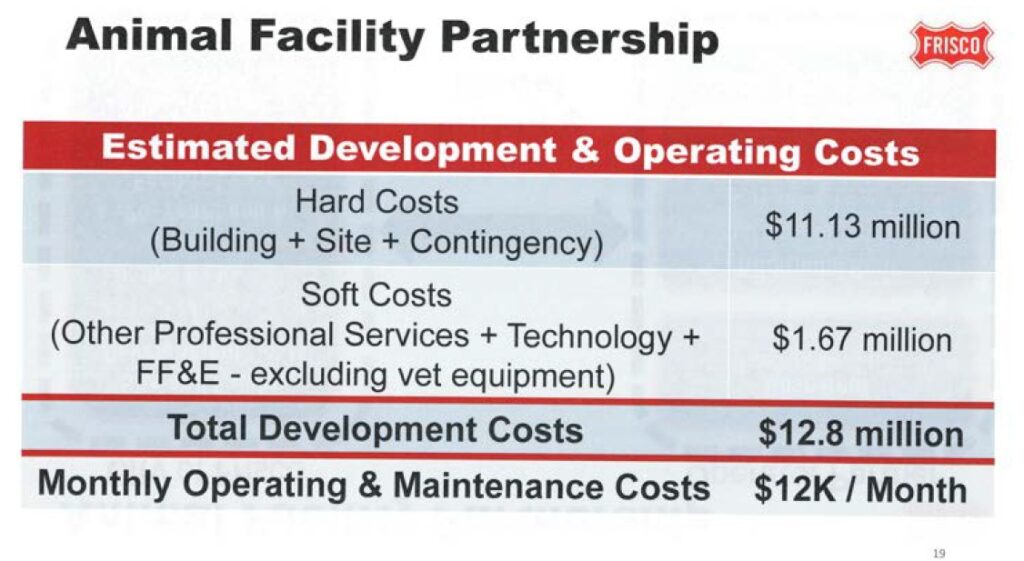
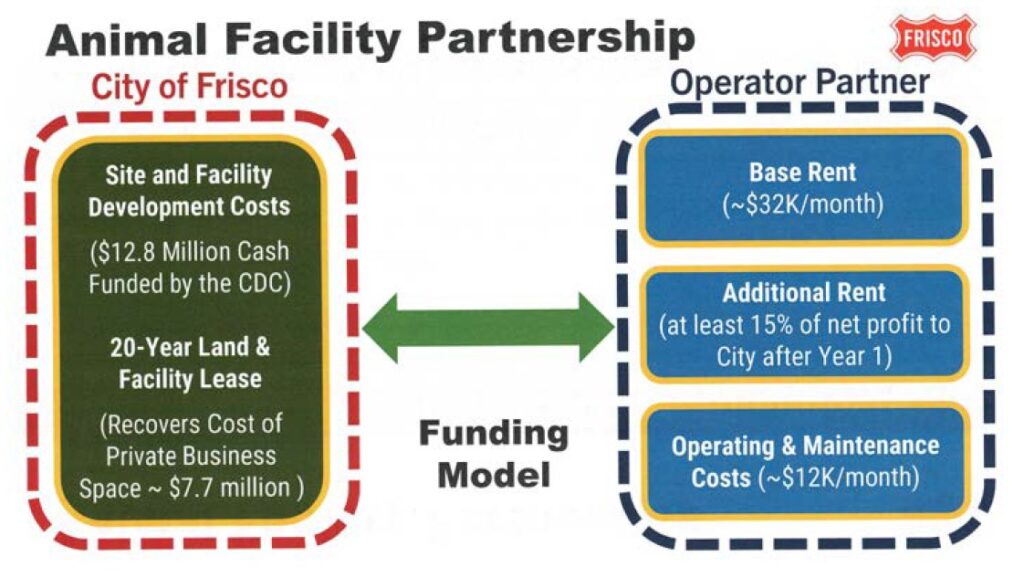
- Does operator have a 10-year history of financial and business credentials?
- Does the current business currently have a history that shows they can cover the potential monthly cost of over $50k +15% of profits (2nd year)
- What is the back up plan if the operator cannot fulfill its obligations?
- Will, or has, the city publicly advertised for operators now that they have a business model?
- Has there been a Proforma (of Financial Forecast) of Income & Expenses for City
- Has there been a Proforma (projection) for services, policy and operational costs and expenses?
- Is the private entity positioned to benefit financially or professionally from this proposal through their private businesses? If yes, how?
- Furthermore, what is the clear contingency plan if the operation proves unsustainable?
- If the director is unable to meet intake demands or financial goals, there must be a backup strategy—such as returning management to municipal control, restructuring the program, or appointing new leadership—to protect both the animals and the community?
- What type of Contract language will there be: indemnity / insurance / risk allocation: Minimum insurance amounts, municipality indemnity carve-outs, who pays defense costs, and whether municipal immunity applies. Will the city require the private operator as an additional insured (and vice versa as appropriate).
- Procurement transparency: Show how the city selected the vendor, RFQ/RFP documents, competing bids, and legal justification under Local Government Code. Confirm the contract was pro-cured properly.
- Will, or has, the city publicly advertised for operators now that they have a business model?
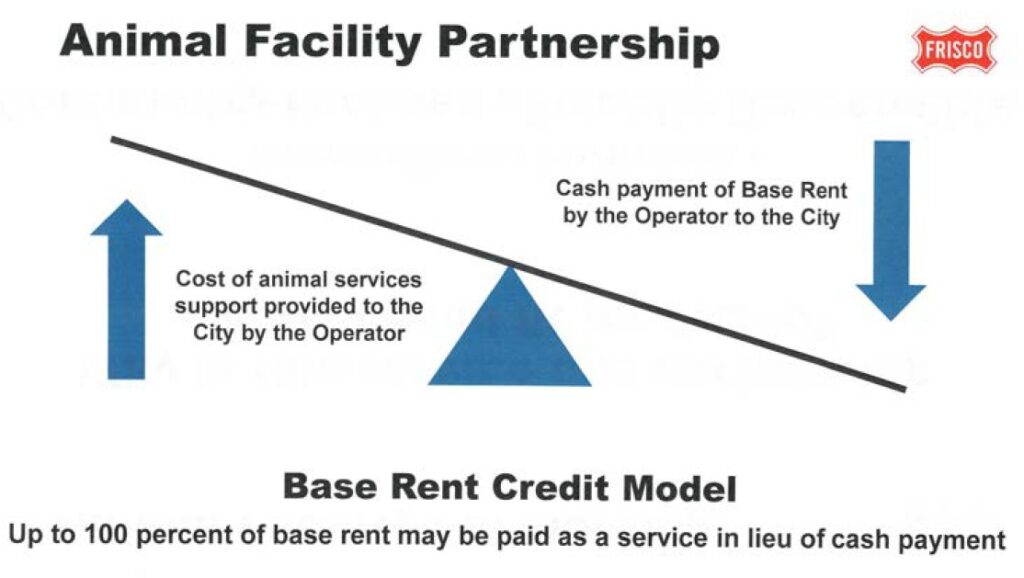
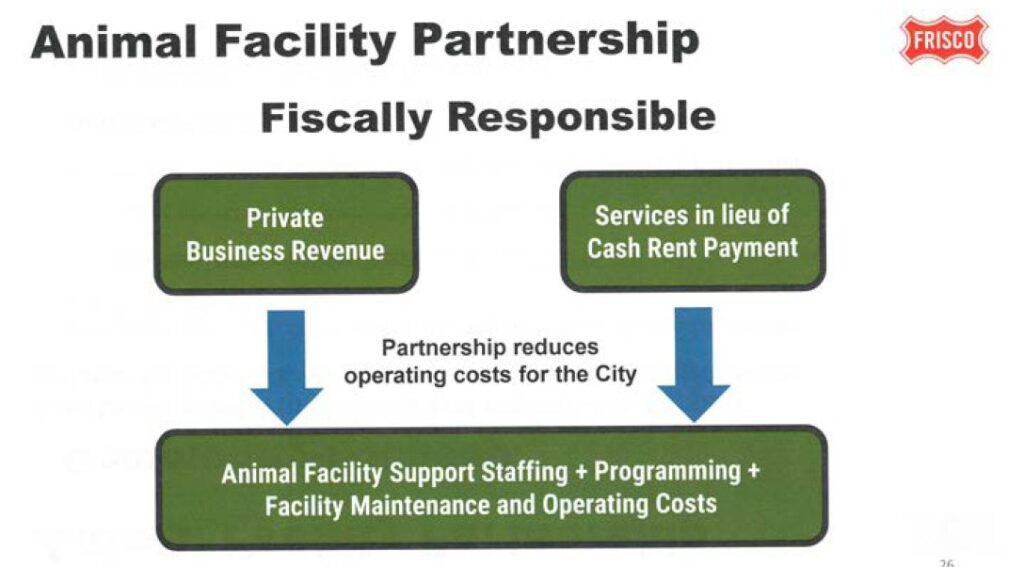
9. Transparency
- With the private partner announcement, did the “private partner” have any input or say on this while in her role on the city’s Animal Advisory Board? Is that a conflict of interest?
- Will she remain on the Animal Advisory Board in the future? Is this a conflict of interest?
- Will employees of the business have access to information on strays and how does this potentially violate privacy issues of residents. What about paying owners privacy?
- Procurement transparency: Show how the city selected the vendor, RFQ/RFP documents, competing bids, and legal justification under Local Government Code. Confirm the contract was procured properly.
In conclusion, this Animal Facility Presented is a liability issue all around. Too many variables have not been considered. This puts the city, the business owner, residents and Frisco pets at risk. There is a reason this has not been done before, so what makes Frisco think they can do it better?
For this to move forward it would need to have strict SOP Clauses in the Contract (to protect taxpayer dollars from potential suits)
Customer consumer protections: “Contractor must obtain written informed consent per Chapter 824 for boarding clients, disclose co-location with municipal shelter, fire-safety systems, and emergency plans; refunds/credit policy for exposure incidents.”
Strict physical separation clause: The contractor shall maintain distinct, walled, separately ventilated areas for municipal-custody animals and boarding/training clientele. No shared runs, HVAC, food/water bowls, or grooming equipment. The floor plan should be reworked to have strays nowhere near a potential owner-owned animal.
Biosecurity & outbreak clause: “Contractor will implement DSHS-recommended isolation, cleaning, and cohorting plans; immediate notification to city and mandatory temporary suspension of boarding if an outbreak is suspected.”
VCPR & veterinary authority clause: “All veterinary care for paid clients must be provided under a documented VCPR; shelter animal care will be under the shelter VCPR as required by law. Contractor will not offer paid medical services to owners of boarded animals without expressed written authorization and compliance with TBVME rules
Insurance & indemnity: “Minimum commercial general liability (specify high limits), professional liability for vet services if provided on site, and contractor named as additional insured on city policy. Contractor indemnifies city for contractor negligence; city indemnifies contractors for actions taken under city directives.”
Records & transparency: “Contractor will maintain intake, medical, and disposition records on premises; microchip scans on intake; monthly reporting to city; records available for audit and subject to public information requests.
Sincerely,
Frisco Animal Advocates
Frisco Animal Facility Presentation: CLICK HERE
Learn More: Frisco Animal Advocates Website
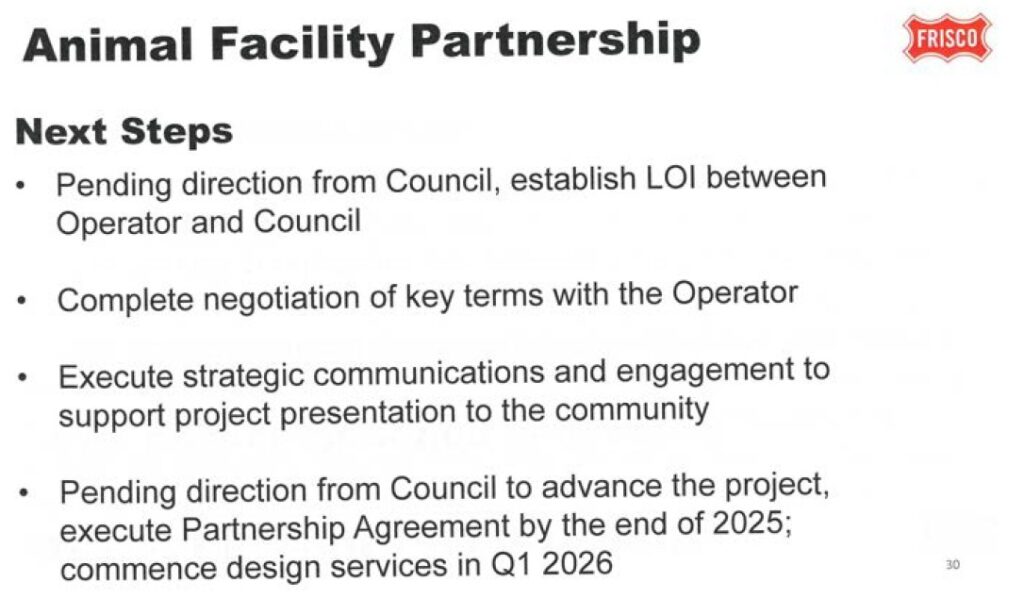
0 Comments